Kastaniani is one of the most beautiful Mastorochoria of Konitsa. The settlement is built amphitheatrically at an altitude of 850-950 m. It is located on the slopes of Mount Gyftissa between the mountains of Smolikas, in a verdant ravine and opposite Pyrsogianni (the other mastorochori).


The amazing location is full of firs, beeches, cedars, hornbeams and mainly chestnuts from which it got its name (chesnut= kastania).


The two streams that pass through the village divide it into three mahalades Messaria, Galina and Rachi.





It is a well-preserved craftsman village with aesthetic and architectural interest with stone houses, two-storey and three-storey mansions, cobbled streets, and bridges within the settlement.


The wonderful examples of local architecture are works of great craftsmen from Kastaniani. They started as stone craftsmen in the village, participated with the famous mpouloukia in the construction of many well-known projects in many places not only in the region but also in the rest of Greece and abroad, and developed into public works contractors.


According to the website kastaniani.gr, the foundation of the settlement in its current location is placed at the beginning of the 11th century AD. After the liberation of Epirus and its integration into the Greek state, Kastaniani became the seat of a community, which was maintained until 1998, when it joined the Municipality of Mastorohoria.
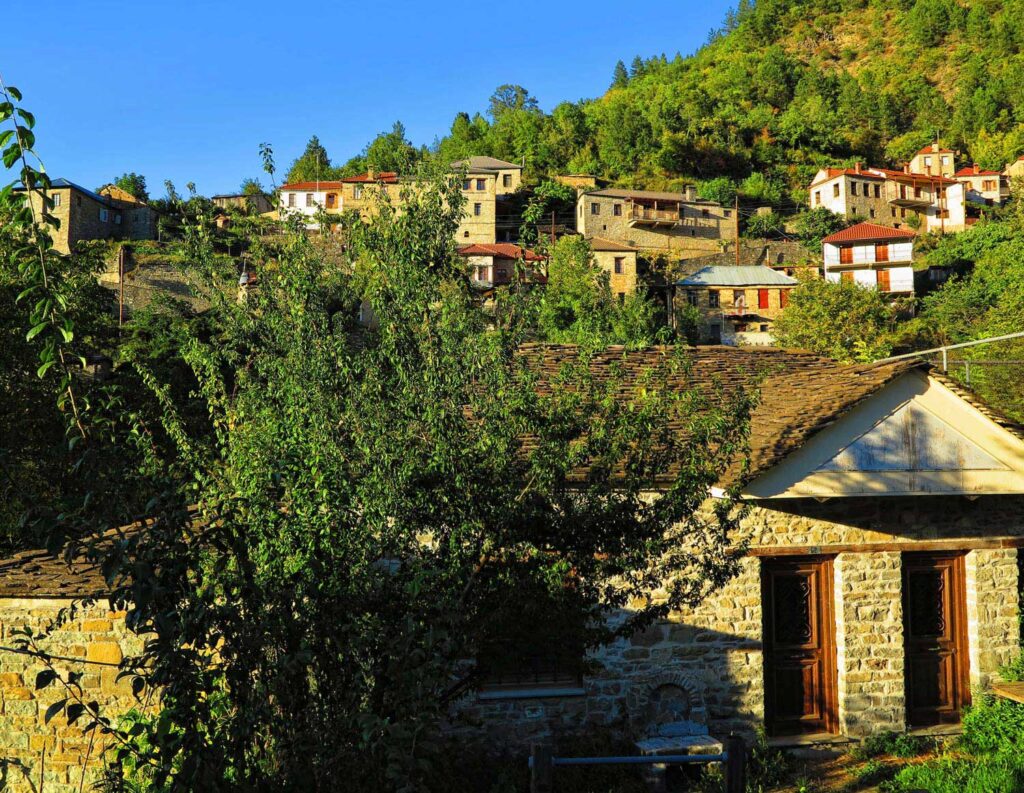

Historical information about Kastaniani
There are no historical records on the founding of the settlement, but according to tradition and the discovery of some findings, it is believed that the first settlement was built around 600-700 AD in the location Skourlia at the foot of Gyftissa, but it was destroyed by the invasions of the Huns and the Slavs. The second settlement was built in the location Malnitsa around 900 AD where they built a fortress at the castle of Kastri.
During the same period, the Monastery of the Transfiguration of the Savior was built in a fortified form. During the invasions of the Huns, Bulgarians, Serbs, Albanians and others, the monastery was the place where the inhabitants resorted to repulse the attackers. At this time, when the village was located in the location Malnitsa, there was an invasion that forced the residents to take refuge in the location Kastri, but eventually the attackers invaded the fortress.




The third attempt to establish a new settlement was made in 1018 at the current location, which was considered safer. The church of Panagia was built in 1018 at the edge of the Gkalyna neighborhood, a date that testifies to the village’s construction date. A settlement always began with the construction of the church. At the point where the village was built, residents built churches on the hills as fortresses with slings.
The raids of the Serbs in 1059 and the Slavs in 1071 devastated the area, leaving Slavic place names in their wake. Nevertheless, according to earlier oral testimonies, the residents spoke the Greek language and were involved in animal husbandry and agriculture.
From 1204, after the first siege of Constantinople, the Konitsa region belonged to the Despotate of Epirus until its conquest by the Turks.
Source: The information on this section has been translated from the Greek text which is based on the book “Ιστορία της Καστάνιανης Κονίτσης” of Mr. Christos N. Gassios.




The Turkish Rule
In 1438, the entire province of Konitsa was subjugated by the Turks and Kastaniani followed the fate of Epirus. During the period of 1775-1780, Albanian bandits attacked the entire region of Epirus, burning, killing, and looting. In 1778, Ali Pasha managed to secure his appointment in the province of Ioannina and to pursue the Albanians, imposing order.
Kastaniani did not become a chiflik, remaining state property, a fact that secured it some privileges and flourished contrary to other villages that became the chifliks of beys, and it became a large village of the Kazas (province) of Konitsa with 833 residents according to the Ottoman Statistics (Salnamé) of 1895.
During the 19th century, the phenomenon of banditry, which was rampant throughout the Ottoman Empire and particularly in Epirus, forced many of the residents (about 50 families) to emigrate and settle in various villages and cities of the then-free Greek state, and most of them did not return.
Source: The information on this section has been translated from the Greek text which is based on the book “Ιστορία της Καστάνιανης Κονίτσης” of Mr. Christos N. Gassios.


Liberation of Kastaniani from Turkish Sovereignty
In 1912, the Greece-Turkey war was declared and those from Kastaniani who were able to fight ran to participate. On February 8, 1913, Molista was occupied by the Greek Army, while on February 14, the historic Battle of Molista took place between the retreating Turkish units and the Greeks. On February 21, 1913, Kastaniani was liberated from the Turkish rule.
Source: The information on this section has been translated from the Greek text which is based on the book “Ιστορία της Καστάνιανης Κονίτσης” of Mr. Christos N. Gassios.


World War II and Civil War
The position of Kastaniani and the villages of the wider area of northern Pindos, as they were located at a point of strategic importance, formed the bulwark of national defense. It is due to this strategic significance that the region later became a theater of fighting during both the period of the National Resistance and the Civil War.
The Italian occupation was particularly harsh, especially in the areas that the Italians aimed to annex to their state in the future. The hostility of the residents was bound to exceed in intensity the dissatisfaction with the invasion of the German army in Continental Greece.


The period of the civil war was a tough and tragic time. Kastaniani and all Mastorochoria were deserted because they were in the war zone. Except for those who were killed, a large part of the population was forcibly displaced, and thousands of political refugees ended up in Eastern Europe. With the civil war, the demographic, economic, and social crisis that existed increased, and the decline was accelerated. In the 60s and 70s, the last big migration wave deserted the area.
Source: The information on this section has been translated from the Greek text which is based on the book “Ιστορία της Καστάνιανης Κονίτσης” of Mr. Christos N. Gassios.


Social Organization
There was a strict division of labor and gender segregation. Only men participated in various events and festivities (zaferia). Later, they began to bring their wives too. At weddings and funerals, women sat in different rooms. It was strictly forbidden for men and women to hold hands, especially if they were not related. Girls were not sent to school with the excuse “not to learn to write to the boyfriend”.
The social organization of the village was mainly based on the large extended family, and there were also isolated families whose members were integrated into these kindred groups based on their father’s ancestry.
Marriage was allowed to third cousins because they believed that there was no relationship beyond this degree. After all, the village was endogamous and at the local level. Few engagements had taken place, according to the registry, with neighboring villages because it was considered offensive to marry a girl outside the village.
Another characteristic of the village, as in the wider area, was the change of the groom’s surname when he came to settle in the house of a single daughter or a girl without brothers. This was evidence that the principle of organization of the “house” was stronger than the generation and the organization based on the principle of blood, which in their perceptions symbolizes paternal ancestry.
Source: The information on this section has been translated from the Greek text which is based on the book “Κοινωνική οργάνωση – Οικιακή οικονομία: Ο κύκλος ανάπτυξης της οικιακής ομάδας στην ορεινή κοινότητα Καστάνιανης Κόνιτσας” of Mr. Alexakis Eleftherios.




The craftsmen of Kastaniani and their work
The craftsmen of Kastaniani were highly valued as artisans, not only for the excellent construction of the buildings, but also for the exceptional quality of the local stone that allowed them to build “isosceles” or “straight” as they said in the local dialect. According to references to their work (archives of Ali Pasha of Tepelene), their contribution to the reconstruction of the Castle of Ioannina, where the “rewarded craftsmen” from Kastaniani were 53, a number that is considered large, is significant.
In the following years, the craftsmen of Kastaniani expanded their activity, leaving remarkable works in the wider area of Epirus and continuing in the rest of Greece as well as in Albania.
From the beginning of the 20th century, overseas trips began, mainly traveling to America, where they worked on construction and railway projects. About 100 men from Kastania immigrated to America, and some of them took their wives.
From 1936-1939, many craftsmen worked in Macedonia on technical works and others. They also worked with other craftsmen from the villages of Konitsa at the borders on military works, at the Roupel fortresses, and on the so-called Metaxa Line.
After the end of the Civil War, the area of the border Konitsa was under surveillance with repressive measures and under a special regime that negatively affected the economic and social life and cultural evolution.
Source: The information on this section has been translated from the Greek text which is based on the book “Μάστοροι & Χτίστες από τα Μαστοροχώρια της Κόνιτσας” of Mr. Argiris Petronotis and Mr. Vasilis Papageorgiou.











Churches and chapels
Agios Nikolaos church
It is built in the central square and dedicated to Agios Nikolaos, the patron saint of the village. The main phase of its reconstruction is placed in the period 1915-1920. Its completion took place in 1928, when the first operation took place, but without the interior decoration.


Agios Dimitrios church
The church of Agios Dimitrios is built at the top of the district of Messargia and is the oldest in the village. The church building was also used as a fortress by the inhabitants during the periods of barbaric raids. Until 1938 there was a cemetery in the precinct.
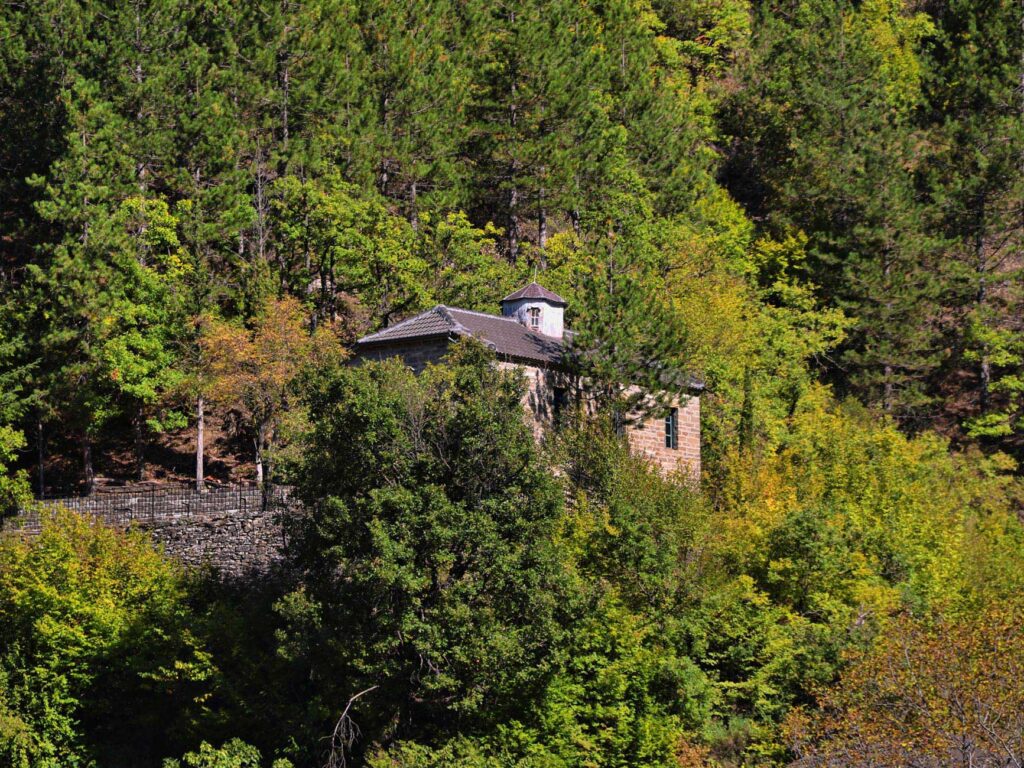

Chapels
In the old days, building a church was considered a sacred debt. After all, most of the craftsmen were in the village and building was not difficult for them. The competition pushed the inhabitants to build chapels on every ridge, peak and hillside.
Some families had undertaken to supervise and maintain them on a permanent basis. Seventeen chapels built around the settlement are associated with the history and tradition of families who were also responsible for their maintenance. They were and are a point of reference and during the festivities the locals and the pilgrims gather to pay tribute to the holy patron.
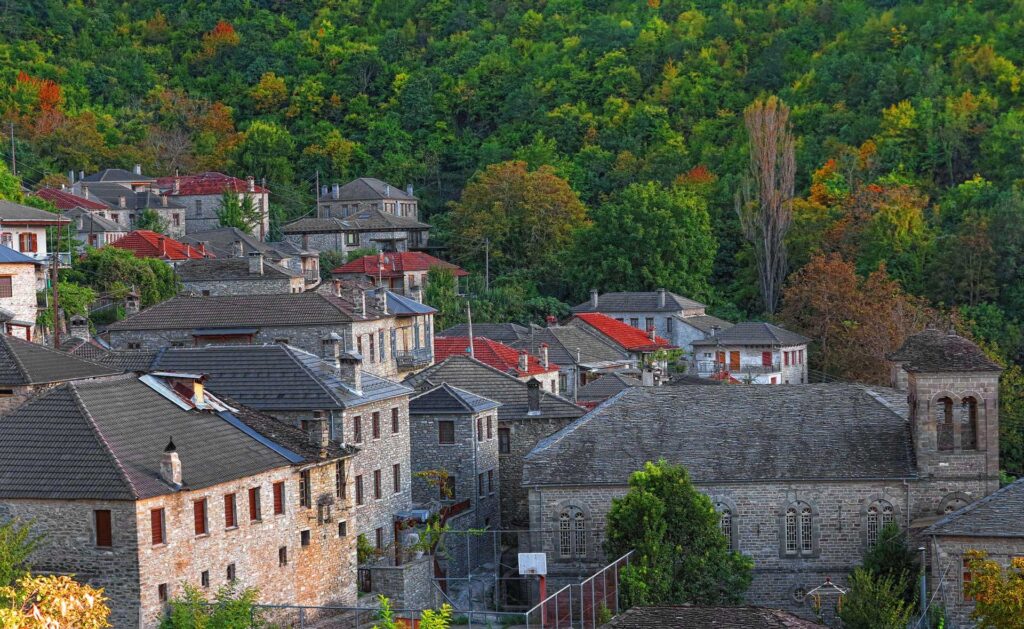

Bridges
Source: The information on this section has been translated from the Greek text which is based on the book “Γεφυρογραφία της Πίνδου” of Spyros I. Mantas.
The bridge of Rachi
It is located in the village between the neighborhoods of Mesargia and Rachi and bridges the pit of Messargia. It was built, probably by an engineer, in 1895 and the parapets were added later, in 1931, with holes for the drainage of rainwater


The bridge of Mitsaioi or Mitsadiko
It is located on the edge of the village and bridges the pit of Rachi next to the house of the Mitsis family. It has an arch made in a purely popular form with a double row of almost wedge-shaped stones. The arch has an opening of 9 meters and a height of 3.80 meters. The passage corridor is almost flat, has a length of 17.75 meters and a width of 2.40 and without the existence of railings or arches.
The bridge has been designated as a historical monument.


The bridge of Malnitsa
It is located in the north outside Kastaniani and bridges in the place Malnitsa the homonymous pit which joins below with the streams of the village and with the name Gostanikos flows into Sarandaporos. The inhabitants crossed the bridge going to their fields, to the chapels that were located on that side and also to the villages of Blistdani (today Lagada), Kantsiko (today Drosopigi) as well as in Macedonia.
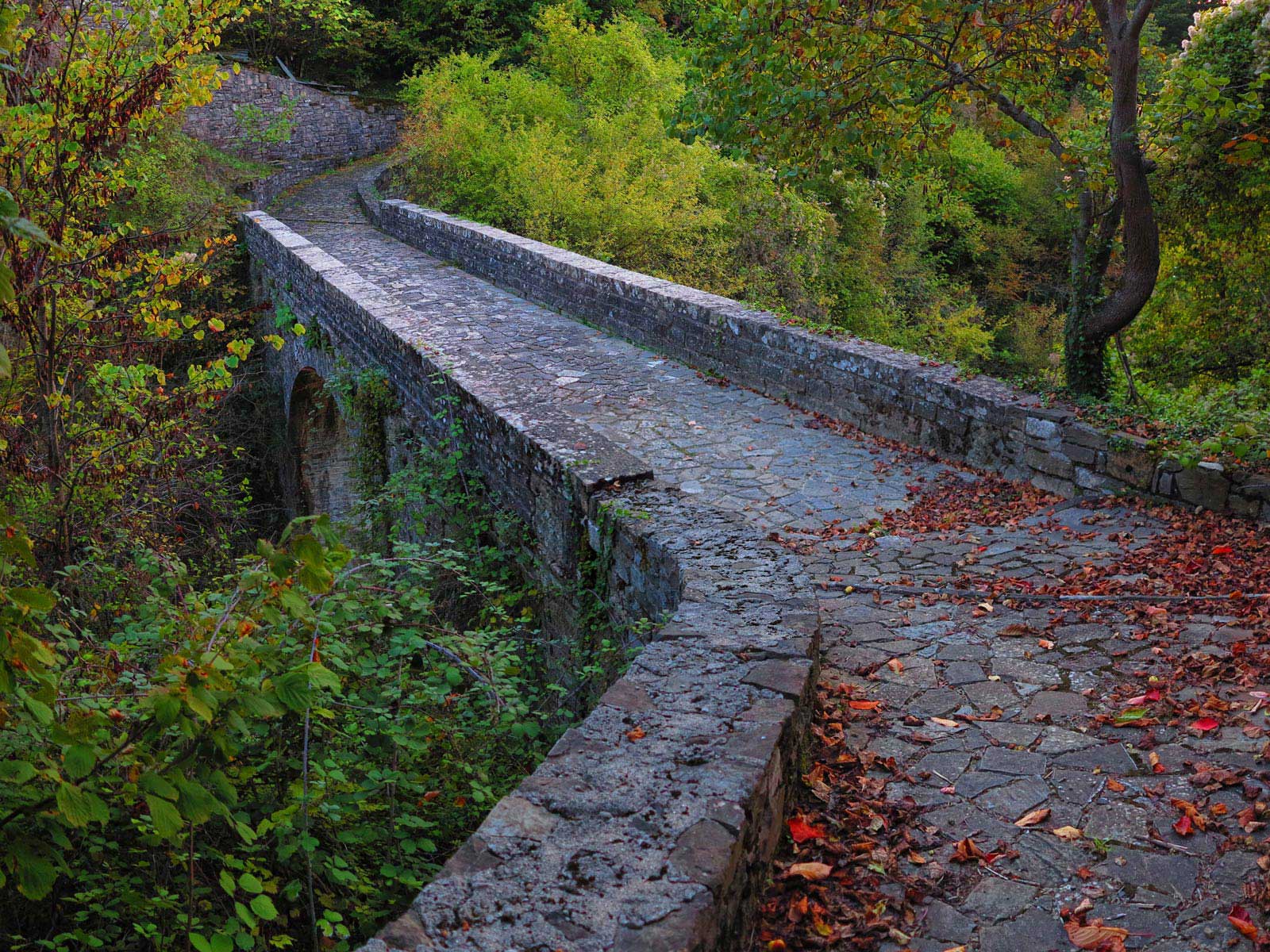

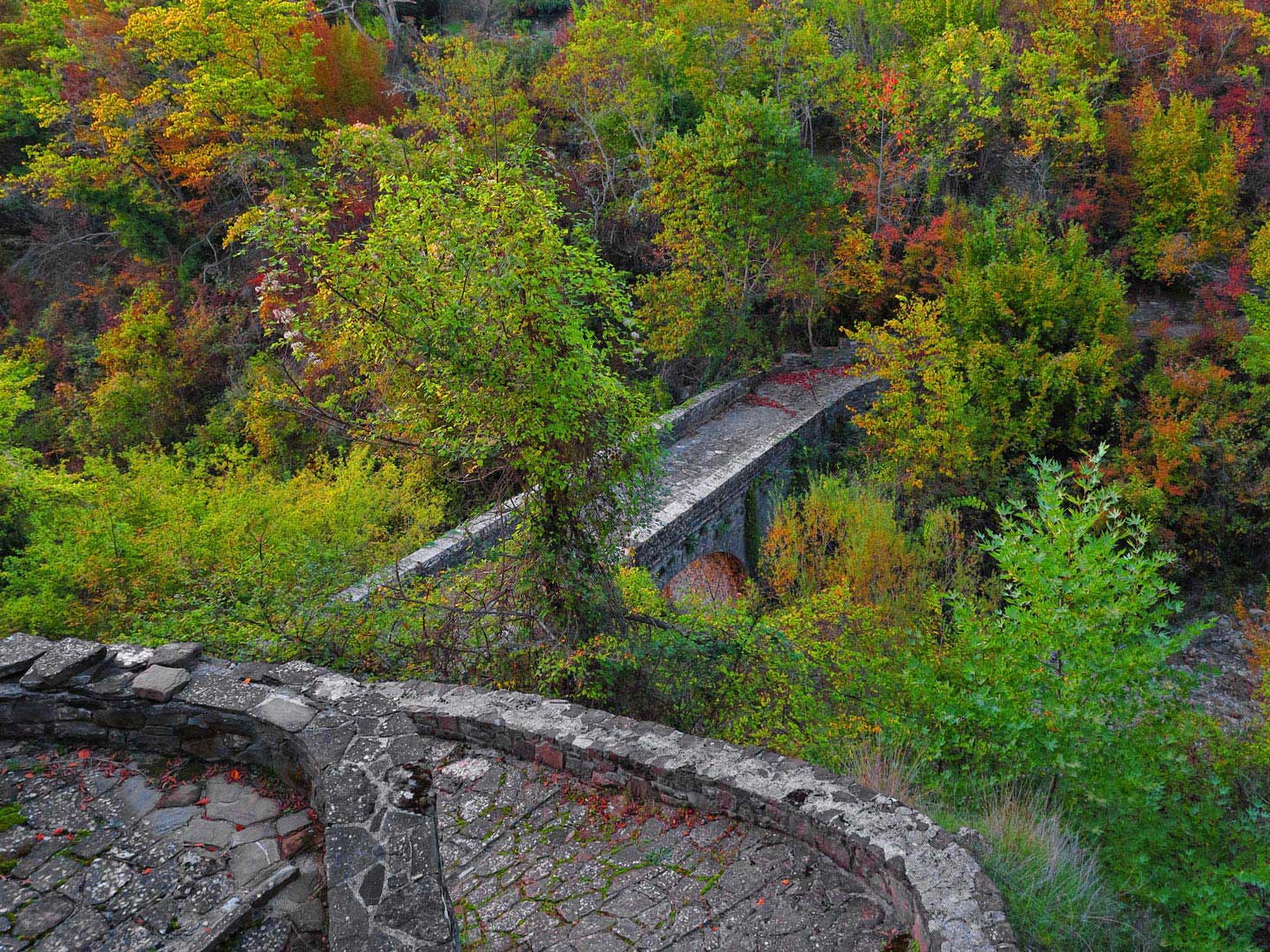

Galina bridge
It is located inside the village. It was built in 1936 on the site of the old damaged bridge. The construction was started by local craftsmen but it was completed by the work of more craftsmen from Tzoumerka.


Activities
The very beautiful locations are ideal for 4×4 tours or hiking.
The village celebrate the Nativity of John the Baptist on June 24 and Agia Paraskevi on July 26.





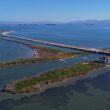




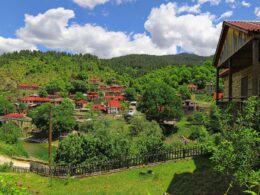
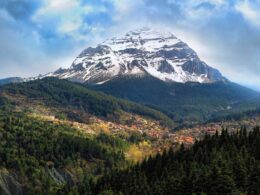
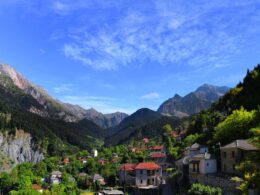
A very beautiful amazing place
Could you please perhaps supply information how to contact your local archives as I think my grandfather Nikolaos Chronos
Origin was from your village He left for South Africa late 1880 ?
Thanking you
Dr Marina Poulos
My grandmother left at that time as well. You should look into the immigration from Greece to South Africa at that time and should be on the ships manifests. Hope that was helpful because to get information from the village might not be useful being many if not all records were burned in the world wars 1 and 2.